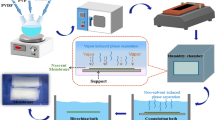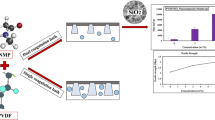Abstract
Hydrophobic symmetric flat-sheet membranes of polyvinylidene fluoride (PVDF) for use in vacuum membrane distillation (VMD) were successfully fabricated by the vapor-induced phase separation (VIPS) method using the double-layer casting process. To avoid the delamination that often occurs in double-layered membranes, the same PVDF polymer was employed in both the upper layer and support layer casting solutions. Solutions with low and high PVDF contents were co-cast as the upper layer and support layer of the membrane that was formed. In the VIPS process, the low PVDF content solution favored the formation of a layer with a porous and hydrophobic surface, whereas the solution with a high PVDF concentration favored the formation of a layer with high mechanical strength. The effect of the vapor-induced time on the morphological properties of the membranes was studied. As the vapor-induced time was increased, the cross-section of the membrane changed from an asymmetrical finger-like structure to a symmetrical sponge-like structure, and the surface of the membrane became rough and porous. The membrane subjected to the longer vapor-induced time also exhibited a higher permeating flux during the VMD process. The best PVDF membrane fabricated in this study had a mean radial pore size of 0.49 μm, and the rough upper surface produced a static contact angle of 145° with water. During the VMD process with a 3.5 wt.% sodium chloride (NaCl) aqueous solution, the best membrane that was fabricated produced a permeating flux of 22.4 kg m−2 h−1 and an NaCl rejection rate of 99.9 % at a feed temperature of 73 °C and a downstream pressure of 31.5 kPa. This performance is comparable to or superior to the performances of most of the flat-sheet PVDF membranes reported in the literature and a polytetrafluoroethylene membrane used in this study.













Similar content being viewed by others
Abbreviations
- A :
-
Effective area of the membrane (m2)
- B :
-
Geometric factor
- B a :
-
Gas permeance coefficient (mol m−2 S−1 Pa−1)
- C f :
-
Concentration in the feed solution (g L−1)
- C p :
-
Concentration in the permeate (g L−1)
- I 0 :
-
Intercept defined in Eq. 2 (mol m−2 S−1 Pa−1)
- J :
-
Permeate flux (kg m−2 h−1)
- k B :
-
Boltzmann constant (J K−1)
- L P :
-
Effective pore length (m)
- LEP w :
-
Water entry pressure (Pa)
- M :
-
Molecular weight of gas (kg mol−1)
- P :
-
Total pressure (Pa)
- P m :
-
Mean pressure (Pa)
- ΔP :
-
Transmembrane pressure (Pa)
- P downstream :
-
Pressure at downstream (Pa)
- \( P_{\text{water}}^{\text{vap} } \) :
-
Vapor pressure of pure water (Pa)
- Q :
-
Total mass of the permeate (kg)
- r :
-
Membrane pore radius (m)
- R :
-
Gas constant (J mol−1 K−1)
- R j :
-
Rejection rate (%)
- S 0 :
-
Slope defined in Eq. 2 (mol m−2 S−1 Pa−2)
- T :
-
Absolute temperature (K)
- t :
-
Running time (h)
- α water :
-
Activity of water
- δ :
-
Membrane thickness (m)
- λ :
-
Mean free path (m)
- γ L :
-
Liquid surface tension (Pa m)
- ε :
-
Porosity (%)
- ε/L P :
-
Effective porosity (m−1)
- τ :
-
Tortuosity of membrane
- μ :
-
Gas viscosity (kg m−1 s−1)
- θ :
-
Liquid/solid contact angle (°)
- ρ :
-
Density (kg m−1 s−1)
- σ :
-
Collision diameter (m)
References
Felinia E, May May T, Tai-Shung C (2012) Effects of additives on dual-layer hydrophobic–hydrophilic PVDF hollow fiber membranes for membrane distillation and continuous performance. Chem Eng Sci 68:567–578
Khayet M, Cojocaru C (2012) Air gap membrane distillation: desalination, modeling and optimization. Desalination 287:138–145
Young-Deuk K, Kyaw T, Noreddine G, Kim-Choon N (2013) Performance investigation of a solar-assisted direct contact membrane distillation system. J Membr Sci 427:345–364
Khayet M (2010) Experimental design and optimization of asymmetric flat-sheet membranes prepared for direct contact membrane distillation. J Membr Sci 351:234–245
Osman MS, Schoeman JJ, Baratta LM (2010) Desalination/concentration of reverse osmosis and electrodialysis brines with membrane distillation. Desalin Water Treat 24:294–301
Huayan C, Chunrui W, Yue J (2011) Comparison of three membrane distillation configurations and seawater desalination by vacuum membrane distillation. Desalin Water Treat 28:321–327
Bandini S (1992) Separation efficiency in vacuum membrane distillation. J Membr Sci 73:217–229
Bandini S (1997) Vacuum membrane distillation: Experiments and modeling. AICHE J 43:398–408
Bandini S (1999) Heat and mass transport resistances in vacuum membrane distillation per drop. AICHE J 45:1422–1433
Sarti GC (1993) Extraction of organic components from aqueous streams by vacuum membrane distillation. J Membr Sci 80:21–33
Mengual JI (2004) Heat and mass transfer in vacuum membrane distillation. Int J Heat Mass Transf 47:865–75
Li Z, Congjie G (2010) The prospective application of membrane distillation in the metallurgical industry. Membr Technol 5:6–10
Qtaishat M (2009) Preparation and characterization of novel hydrophobic/hydrophilic polyetherimide composite membranes for desalination by direct contact membrane distillation. J Membr Sci 327:264–273
Khayet M (2011) Membranes and theoretical modeling of membrane distillation: a review. Adv Colloid Interf Sci 164:56–88
Khayet M, Matsuura T (2001) Preparation and characterization of polyvinylidene fluoride membranes for membrane distillation. Ind Eng Chem Res 40:5710–5718
Feng CS (2006) Factors affecting pore structure and performance of poly(vinylidene fluoride-co-hexafluoro propylene) asymmetric porous membrane. J Membr Sci 277:55–64
Cheng LP (1994) An improved model for mass transfer during the formation of polymeric membranes by the immersion–precipitation process. J Polymer Sci, Part B: Polymer Phys 32:1413–25
Kao ST (2008) Fabricating PC/PAN composite membranes by vapor-induced phase separation. Desalination 233:96–103
Shin SJ (2005) Preparation and characterization of polyethersulfone microfiltration membranes. Desalination 186:1–10
Tsai HA (2006) Morphology control of polysulfone hollow fiber membranes via water vapor induced phase separation. J Membr Sci 278:390–400
Li XM (2008) A sacrificial-layer approach to prepare microfiltration membranes. J Membr Sci 320:1–7
Yuelian P, Hongwei F, Ju G, Shaobin W, Ping C, Qi J (2012) The effects of processing conditions on the surface morphology and hydrophobicity of polyvinylidene fluoride membranes prepared via vapor-induced phase separation. Appl Surf Sci 263:737–744
Hongwei F, Yuelian P (2012) Application of PVDF membranes in desalination and comparison of the VMD and DCMD processes. Chem Eng Sci 79:94–102
Pereira CC (2001) Membranes obtained by simultaneous casting of two polymer solutions. J Membr Sci 192:11–26
Pereira CC (2003) Hollow fiber membranes obtained by simultaneous spinning of two polymer solutions: a morphological study. J Membr Sci 226:35–50
Smolder K, Franken ACM (1989) Terminology for membrane distillation. Desalination 72:249–262
Qtaishat M (2009) Novel porous composite hydrophobic/hydrophilic polysulfone membranes for desalination by direct contact membrane distillation. J Membr Sci 341:139–48
Jun S, Quan Y, Congjie G (2001) Membrane technical manuals. Chemical Industry Press (CIP), Beijing, p 78
Khayet M (2004) Characterization of membranes for membrane distillation by atomic force microscopy and estimation of their water vapor transfer coefficients in vacuum membrane distillation process. J Membr Sci 238:199–211
Khulbe KC, Matsuura T (2000) Characterization of synthetic membranes by Raman spectroscopy, electron spin resonance and atomic force microscopy: a review. Polymer 41:1917–1935
Khayet M (2001) Modelling transport mechanism through a porous partition. J Non-Equil Thermody 26:1–14
Yuelian P, Hongwei F, Yajun D, Yanna S, Hua H (2012) Effects of exposure time on variations in the structure and hydrophobicity of polyvinylidene fluoride membranes prepared via vapor-induced phase separation. Appl Surf Sci 258:7872–7881
Peng M (2005) Porous poly(vinylidene fluoride) membrane with highly hydrophobic surface. J Appl Polym Sci 98:1358–1363
Xuyun W (2009) Formation mechanism and crystallization of poly(vinylidene fluoride) membrane via immersion precipitation method. Desalination 236:170–78
Stawikowska J, Livingston AG (2013) Assessment of atomic force microscopy for characterisation of nanofiltration membranes. J Membr Sci 425–426:58–70
MMA Shirazi, D Bastani, A Kargari, M Tabatabaei (2013) Characterization of polymeric membranes for membrane distillation using atomic force microscopy. Desalin Water Treat (in press)
Khayet M (2000) Theory and experiments on sweeping gas membrane distillation. J Membr Sci 165:261–272
Alklaibi AM, Lior N (2005) Membrane-distillation desalination: status and potential. Desalination 171:111–131
Couffin N (1998) A new process to remove halogenated VOCs for drinking water production: vacuum membrane distillation. Desalination 117:233–245
Cath TY (2004) Experimental study of desalination using direct contact membrane distillation: a new approach to flux enhancement. J Membr Sci 228:5–16
Imdakm AO (2007) A Monte Carlo simulation model for vacuum membrane distillation process. J Membr Sci 306:341–348
Lawson KW, Lloyd DR (1996) Membrane distillation 1. Module design and performance evaluation using vacuum membrane distillation. J Membr Sci 120:111–121
Kai-Yu W, Suay-Wei F, Tai-Shung C (2009) Mixed matrix PVDF hollow fiber membranes with nanoscale pores for desalination through direct contact membrane distillation. Ind Eng Chem Res 48:4474–4483
Mericq JP, Laborie S, Cabassud C (2009) Vacuum membrane distillation for an integrated seawater desalination process. Desalin Water Treat 9:287–296
Feng C (2008) Production of drinking water from saline water by air-gap membrane distillation using polyvinylidene fluoride nanofiber membrane. J Membr Sci 311:1–6
Mohammad Mahdi AS, Kargari A, Mohammad Javad AS (2012) Direct contact membrane distillation for seawater desalination. Desalin Water Treat 49:368–375
Khayet M, Mengual JI, Matsuura T (2005) Porous hydrophobic/hydrophilic composite membranes: application in desalination using direct contact membrane distillation. J Membr Sci 252:101–113
Eumine Suk D, Matsuura T (2010) Development of novel surface modified phase inversion membranes having hydrophobic surface-modifying macromolecule (nSMM) for vacuum membrane distillation. Desalination 261:300–312
Tang N (2010) Preparation and morphological characterization of narrow pore size distributed polypropylene hydrophobic membranes for vacuum membrane distillation via thermally induced phase separation. Desalination 256:27–36
Acknowledgements
The authors would like to thank Professor Liu Zhongzhou of the Research Center for Eco-Environmental Science, the Chinese Academy of Sciences, for his valuable discussions and suggestions. The authors also thank the National Natural Science Foundation of China for financial support (21176008).
Author information
Authors and Affiliations
Corresponding author
Rights and permissions
About this article
Cite this article
Fan, H., Peng, Y., Li, Z. et al. Preparation and characterization of hydrophobic PVDF membranes by vapor-induced phase separation and application in vacuum membrane distillation. J Polym Res 20, 134 (2013). https://doi.org/10.1007/s10965-013-0134-4
Received:
Accepted:
Published:
DOI: https://doi.org/10.1007/s10965-013-0134-4




